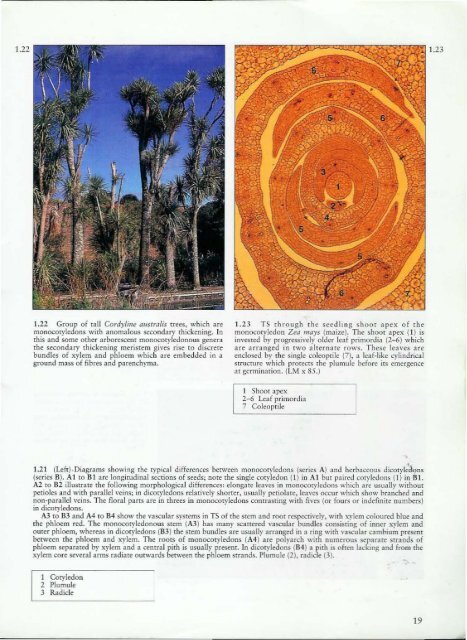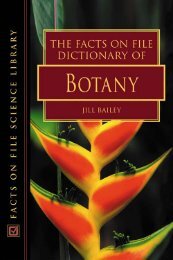You also want an ePaper? Increase the reach of your titles
YUMPU automatically turns print PDFs into web optimized ePapers that Google loves.
1.22<br />
1.22 Group of rail Cordy/hIe al/stralis trees, which are<br />
monocoryledons with anomalous secondary thickening. In<br />
this and !>Ome other arborescem monocotyledonous genera<br />
the secondary thickening meristem gives rise to discrete<br />
bundles of xylem and phloem which are embedded in a<br />
ground mass of fibres and parenchyma.<br />
1.23 T$ through the seedlmg shoot apex of the<br />
monocotyledon lea <strong>mays</strong> (maize). The shoot apex (I) is<br />
invested by progressivel)' older leaf primordia (2--6) which<br />
are arranged in twO ahernate rows. These leaves are<br />
enclosed by the single coleoptile (7), a leaf·like cylindrical<br />
structure which protects the plumule before its emergence<br />
at germination. llM x 85.)<br />
1 Shoot apex<br />
2--6 Leaf primordia<br />
7 Coleoptii(o<br />
<<br />
1.21 (Left).Diagrams showing the typical differences between monocotyledons (series A) and herbaceous dicotyledons<br />
(series 8). Al to 81 arc longitudinal sections of seeds; note the single cotyledon (I) in Al but paired cotylt:dons (I) in B1.<br />
A1 to 82 illustrate the following morphological differences: elongate leaves in monocotyledons which :Ire usually without<br />
petioles and with parallel "eins; in dicotyledons relatively shorter, usually petiolate. leaves occur which show bmnched and<br />
non'parallel veins. The floral parts are in thrtts in monocotyledons contrasting with fives (or fours or indefinite numbers)<br />
in dicotyledons.<br />
A3 to 83 and A4 to 84 show tht> v:lscular systems in T$ of rhe srem and root rcspecrively, with xylem coloured blue and<br />
the phloem red. The monocotyledonous stem (A3) has many scanered vascular bundles consisting of inner xylem and<br />
outer phloem, whereas in dicotyledons (B3) the stem bundles are usually arranged in a ring with vascular cambium present<br />
between the phloem and xylem. The roOlS of monocotyledons (A4) are polyarch with numerous separate suands of<br />
phloem separated b)' xylem and a central pith is usuaUy present. In dicotyledons (84) a pith is often lacking. and from the<br />
xylem core several arms radiate outwards between the phloem strands. Plumule (2), radicle (31.<br />
I CoT}'Il"don<br />
2 Plumule<br />
3 Radicle<br />
19<br />
1.23





